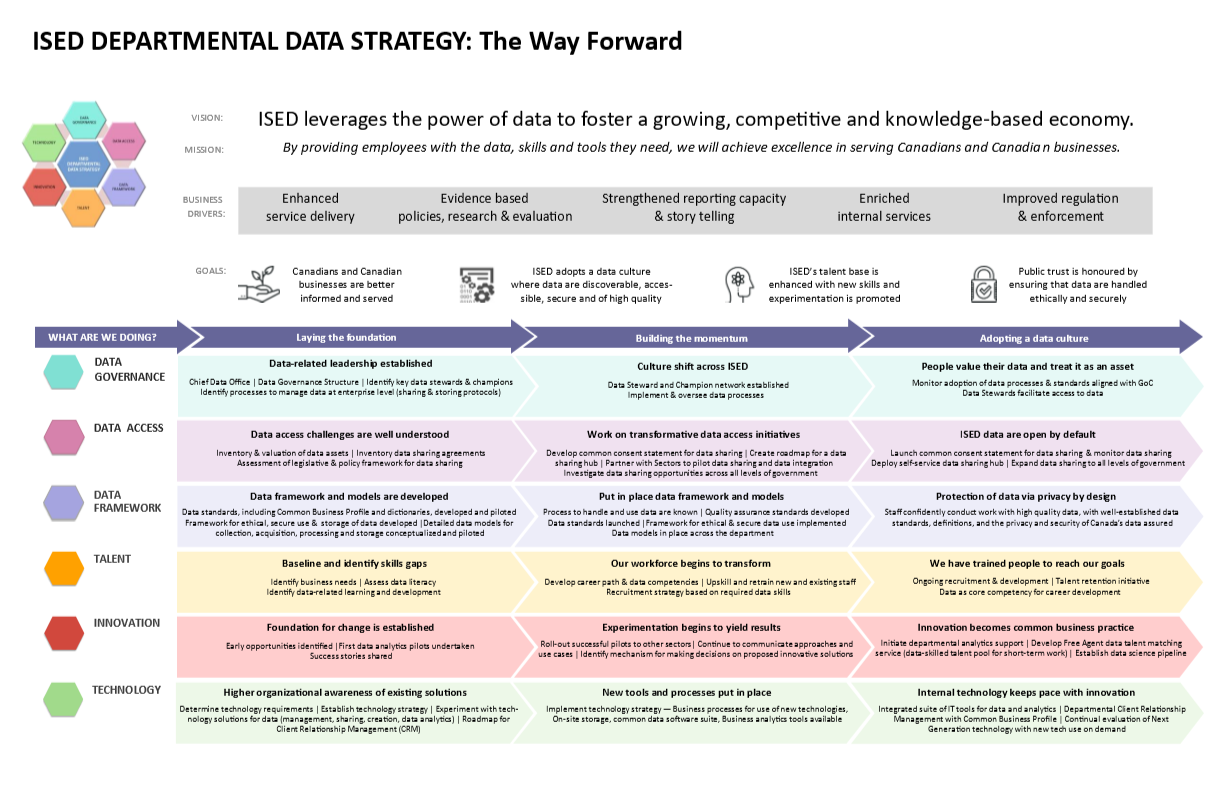|
|
| Line 1: |
Line 1: |
| | ('''Francais''': [[Stratégie ministérielle d'ISDE en matière de données]]) ('''Home Page''': [[ISED Data Strategy]]) | | ('''Francais''': [[Stratégie ministérielle d'ISDE en matière de données]]) ('''Home Page''': [[ISED Data Strategy]]) |
| | + | [[File:ThewayforwardplacematENG.png|none|frame]] |
| | | | |
| | == ISED Departmental Data Strategy: The Way Forward == | | == ISED Departmental Data Strategy: The Way Forward == |
Revision as of 15:49, 5 January 2021
(Francais: Stratégie ministérielle d'ISDE en matière de données) (Home Page: ISED Data Strategy)
ISED Departmental Data Strategy: The Way Forward
Vision:
ISED leverages the power of data to foster a growing, competitive and knowledge based economy.
Mission:
By providing employees with the data, skills and tools they need, we will achieve excellence in serving Canadians and Canadian businesses.
Business Drivers
- Enhanced service delivery
- Evidence based policies, research and evaluation
- Strengthened reporting capacity and story telling
- Enriched internal services
- Improved regulation and enforcement
|
|
|
Goals
- Canadians and Canadian businesses are better informed and served
- ISED adopts a data culture where data are discoverable, accessible, secure and of high quality
- ISED's talent base is enhanced with new skills and experimentation is promoted
- Public trust is honoured by ensuring that data are handled ethically and securely
|
|
|
What are we doing?
There are six pillars of the ISED Data Strategy, each of which has high level initiatives in three phases of implementation; laying the foundation, building the momentum and adopting a data culture. The following table addresses each pillar by phase of implementation.
|
|
Laying the foundations
|
Building the momentum
|
Adopting a data culture
|
Data governance
_____________
|
Data-related leadership established
- Chief Data Office
- Data Governance Structure
- Identify key data stewards & champions
- Identify processes to manage data at enterprise level (sharing & storing protocols)
_______________________
|
Culture shift across ISED
- Data Steward and Champion network established
- Implement & oversee data processes
___________________________________________
|
People value their data and treat it as an asset
- Monitor adoption of data processes & standards aligned with GoC
- Data Stewards facilitate access to data
__________________________
|
Data Access
_____________
|
Data access challenges are well understood
- Inventory & valuation of data assets
- Inventory data sharing agreements
- Assessment of legislative & policy framework for data sharing
_______________________
|
Work on transformative data access initiatives
- Develop common consent statement for data sharing
- Create roadmap for a data sharing hub
- Partner with Sectors to pilot data sharing and data integration Investigate data sharing opportunities across all levels of government
___________________________________________
|
ISED data are open by default
- Launch common consent statement for data sharing & monitor data sharing
- Deploy self-service data sharing hub
- Expand data sharing to all levels of government
_______________________
|
Data Framework
_____________
|
Data framework and models are developed
- Data standards, including Common Business Profile and dictionaries, developed and piloted Framework for ethical, secure use & storage of data developed
- Detailed data models for collection, acquisition, processing and storage conceptualized and piloted
_______________________
|
Put in place data framework and models
- Process to handle and use data are known
- Quality assurance standards developed Data standards launched
- Framework for ethical & secure data use implemented
- Data models in place across the department
___________________________________________
|
Protection of data via privacy by design
- Staff confidently conduct work with high quality data, with well-established data standards, definitions, and the privacy and security of Canada's data assured
_______________________
|
Talent
_____________
|
Baseline and identify skills gaps
- Identify business needs
- Assess data literacy
- Identify data-related learning and development
_______________________
|
Our workforce begins to transform
- Develop career path & data competencies
- Upskill and retrain new and existing staff
- Recruitment strategy based on required data skills
___________________________________________
|
We have trained people to reach our goals
- Ongoing recruitment & development
- Talent retention initiative
- Data as core competency for career development
_______________________
|
Innovation
_____________
|
Foundation for change is established
- Early opportunities identified
- First data analytics pilots undertaken
- Success stories shared
_______________________
|
Experimentation begins to yield results
- Roll-out successful pilots to other sectors
- Continue to communicate approaches and use cases
- Identify mechanism for making decisions on proposed innovative solutions
___________________________________________
|
Innovation becomes common business practice
- Initiate departmental analytics support
- Develop Free Agent data talent matching service (data-skilled talent pool for short-term work)
- Establish data science pipeline
_______________________
|
Technology
_____________
|
Higher organizational awareness of existing solutions
- Determine technology requirements
- Establish technology strategy
- Experiment with technology solutions for data (management, sharing, creation, data analytics)
- Roadmap for Client Relationship Management (CRM)
_______________________
|
New tools and processes put in place
- Implement technology strategy
- Business processes for use of new technologies
- On-site storage, common data software suite
- Business analytics tools available
___________________________________________
|
Internal technology keeps pace with innovation
- Integrated suite of IT tools for data and analytics
- Departmental Client Relationship Management with Common Business Profile
- Continual evaluation of Next Generation technology with new tech use on demand
_______________________
|

